Retired Robots
This page describes some of our older robots and completed projects. Click
here for our active robot page.
Hopper
|
 The hopper is a one-legged hopping robot whose purpose is to study the
balance and energetics of dynamically stable systems. Different control
systems have been developed including a neural network for speed control and a
model-based height controller. The robot is also capable of a scooting mode of
locomotion using only the actuators utilized in hopping.
The hopper is a one-legged hopping robot whose purpose is to study the
balance and energetics of dynamically stable systems. Different control
systems have been developed including a neural network for speed control and a
model-based height controller. The robot is also capable of a scooting mode of
locomotion using only the actuators utilized in hopping.
|
Bandit-I
|
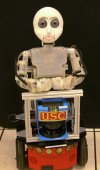 Bandit-I is a prototype humanoid robot. To construct a robot that is cost-effective, we have
made the robot out of servo-motors and rapid-prototyping (rp) material. It has two 6-DOF arms,
a head than can pan and tilt, and a face with movable mouth and eye-brows, and stereo-cameras for
eyes. Our goal for this robot is to have a platform to interact with people with expressive
gestures, and facial expressions.
Bandit-I is a prototype humanoid robot. To construct a robot that is cost-effective, we have
made the robot out of servo-motors and rapid-prototyping (rp) material. It has two 6-DOF arms,
a head than can pan and tilt, and a face with movable mouth and eye-brows, and stereo-cameras for
eyes. Our goal for this robot is to have a platform to interact with people with expressive
gestures, and facial expressions.
|
Clara
|
 Clara is a modular mobile robot platform used in a suite of
assistive robotics projects we are pursuing under the general theme of
Hands-Off Physical Therapy. The robot has been used in experiments with
post-cardiac surgery patients, where it provided guidance and motivation for
tiring and potentially painful breathing exercises. Clara, named after Clara
Barton, the founder of the American Red
Cross, is mounted on an ActivMedia Pioneer 2DX base, and equipped with a
SICK LMS200 scanning laser range-finder, a Sony pan-tilt camera, and a Shure
503BG microphone. Visual displays are shown on a laptop screen positioned near
the top of the robot; the majority of the robot frame and wires are covered by
a custom canvas outfit. Presently, Clara is being used to evaluated the
importance of robot embodiment in assistive human-robot interaction domains.
Clara is a modular mobile robot platform used in a suite of
assistive robotics projects we are pursuing under the general theme of
Hands-Off Physical Therapy. The robot has been used in experiments with
post-cardiac surgery patients, where it provided guidance and motivation for
tiring and potentially painful breathing exercises. Clara, named after Clara
Barton, the founder of the American Red
Cross, is mounted on an ActivMedia Pioneer 2DX base, and equipped with a
SICK LMS200 scanning laser range-finder, a Sony pan-tilt camera, and a Shure
503BG microphone. Visual displays are shown on a laptop screen positioned near
the top of the robot; the majority of the robot frame and wires are covered by
a custom canvas outfit. Presently, Clara is being used to evaluated the
importance of robot embodiment in assistive human-robot interaction domains.
|
RoboMote
|
 Robomote is a sample
mobile platform for sensor networks. It was designed with the objective of
being cheap and compatible with the Berkeley
mote. It has an Atmel 8535 processor for control, IR sensors for obstacle
avoidance and a Magnetometer for bearing. It comes with a TinyOS API so that
the robomote could be controlled from the mote via TinyOS.
Robomote is a sample
mobile platform for sensor networks. It was designed with the objective of
being cheap and compatible with the Berkeley
mote. It has an Atmel 8535 processor for control, IR sensors for obstacle
avoidance and a Magnetometer for bearing. It comes with a TinyOS API so that
the robomote could be controlled from the mote via TinyOS.
|
Sensor Network Testbed
|
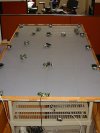 The testbed is an ideal platform for experiments in mobile sensor
networks. It comprises of both 12 static mica1 motes and one or more mobile
motes(robomote). The vision system provides Groundtruth location awareness,
providing us with sub-centimeter location information.
The testbed is an ideal platform for experiments in mobile sensor
networks. It comprises of both 12 static mica1 motes and one or more mobile
motes(robomote). The vision system provides Groundtruth location awareness,
providing us with sub-centimeter location information.
|
R2e
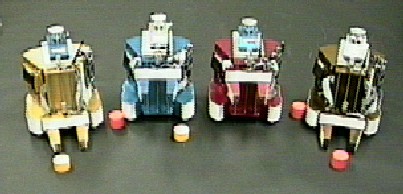 Dubbed "The
Socially Mobile", Don Quixote, Don Corleone, Donna E. Mobile, and The
Donald were manufactured by IS Robotics and were generously given to the
Interaction Lab by Prof. Rodney A.
Brooks from the MIT AI Lab. Each
R2e robot is a holonomic base actuated with two drive motors and equipped
with a two-fingered gripper. The sensors include piezo-electric bump
sensors on the inside panels and in the gripper, five infra red (IR)
sensors around the body and one on each finger, a color sensor in the
gripper, a radio transmitter/receiver for communication and data
gathering, a base station, and an ultrasound triangulation system for
positioning. The robots are programmed in the Behavior Language based on
the Subsumption Architecture. The Socially Mobile have participated in
various experiments on group behavior and multi-robot learning, and have
provided data for developing analysis and modeling methods. (Mataric´, Goldberg)
Dubbed "The
Socially Mobile", Don Quixote, Don Corleone, Donna E. Mobile, and The
Donald were manufactured by IS Robotics and were generously given to the
Interaction Lab by Prof. Rodney A.
Brooks from the MIT AI Lab. Each
R2e robot is a holonomic base actuated with two drive motors and equipped
with a two-fingered gripper. The sensors include piezo-electric bump
sensors on the inside panels and in the gripper, five infra red (IR)
sensors around the body and one on each finger, a color sensor in the
gripper, a radio transmitter/receiver for communication and data
gathering, a base station, and an ultrasound triangulation system for
positioning. The robots are programmed in the Behavior Language based on
the Subsumption Architecture. The Socially Mobile have participated in
various experiments on group behavior and multi-robot learning, and have
provided data for developing analysis and modeling methods. (Mataric´, Goldberg)
|
Kheperas
|
The lab is equipped with 4 small, networked K-team Khepera robots. Each module
contains a dedicated 68331 processor, and is 3 inches in diameter,
equipped with a gripper turret. The height is modular, based on what
sensory systems are used. The sensory capabilities include position
encoders in the wheels and 8 infra-red emitter detector pairs for obstacle
avoidance. A radio turret enables communication over UHF frequencies at
4800 Kbits/sec.
These robots have been used for various projects. In one, named SKITs (Sub-Kilogram
Intelligent Telerobots), they were used to model small space robots
accessing untapped resources of asteroids. Hardware and software
simulation studies were performed determine the relative merits of
using colonies of sub-kilogram robots for this endevour. In another,
the robots were used to study flexible, adaptive coordination of robot
formations. In a third, a pair
of Kheperas is used to cooperatively move an object.
|
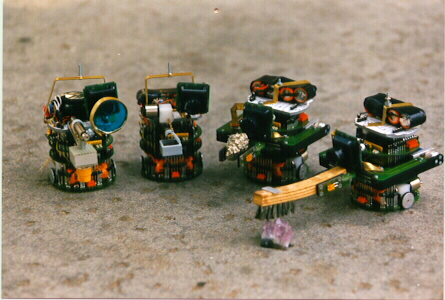
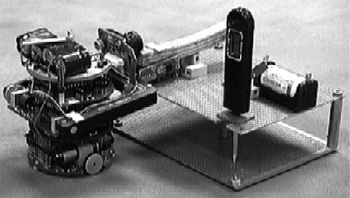
|
MENO
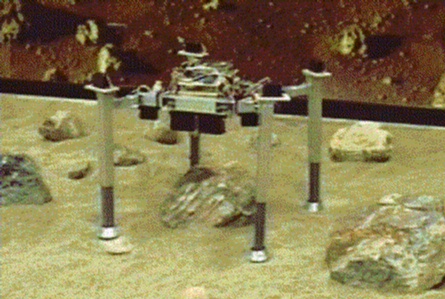 MENO is a 12 DOF walking robot built and programmed by Gaurav Sukhatme, Scott Cozy and
Scott Brizius. The detailed design and control methodology is the subject
of a paper that appeared recently. Each leg is a rotational, rotational,
prismatic structure actuated by three servos. The robot has several simple
sensors. Each foot has a contact sensor to detect ground contact, a switch
that detects hyper-retraction of the prismatic joint and a switch ring
that detects contact with obstacles when the leg is swung. The robot uses
an inclinometer to maintain balance and walks in a variety of statically
stable gaits. A frontal sonar is used to detect obstacles. All processing
is done onboard using a Motorola 68332 processor programmed in C. The
robot was used as a testbed for experiments in mobility benchmarking
experiments on a project funded by the JPL Mars explorer program. The robot will be used in the future for experiments in cerebellar control.(MARS Team)
MENO is a 12 DOF walking robot built and programmed by Gaurav Sukhatme, Scott Cozy and
Scott Brizius. The detailed design and control methodology is the subject
of a paper that appeared recently. Each leg is a rotational, rotational,
prismatic structure actuated by three servos. The robot has several simple
sensors. Each foot has a contact sensor to detect ground contact, a switch
that detects hyper-retraction of the prismatic joint and a switch ring
that detects contact with obstacles when the leg is swung. The robot uses
an inclinometer to maintain balance and walks in a variety of statically
stable gaits. A frontal sonar is used to detect obstacles. All processing
is done onboard using a Motorola 68332 processor programmed in C. The
robot was used as a testbed for experiments in mobility benchmarking
experiments on a project funded by the JPL Mars explorer program. The robot will be used in the future for experiments in cerebellar control.(MARS Team)
|
R1
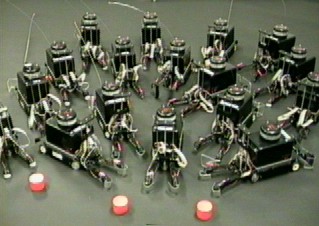 The Nerd Herd is a gang of 20 R1 robots manufactured by ISX/IS
Robotics. They are Ackerman steered bases about 13" long with "forks"
that can be used to pick up and stack objects. They have IR and
contact sensors on the ends of the forks, bump sensors on the sides
and back, and a radio-sonar positioning and communication system.
They are controlled by a network of 68HC11 processors programmed in
the Behavior Language. These robots were the first to demonstrate
large scale group behavior (foraging, following, flocking, etc. with
up to 13 robots); now they are in need of some body-building, and are
largely used as mobile/dynamic obstacles and targets in other
multi-robot control and coordination experiments. (Mataric, Werger)
The Nerd Herd is a gang of 20 R1 robots manufactured by ISX/IS
Robotics. They are Ackerman steered bases about 13" long with "forks"
that can be used to pick up and stack objects. They have IR and
contact sensors on the ends of the forks, bump sensors on the sides
and back, and a radio-sonar positioning and communication system.
They are controlled by a network of 68HC11 processors programmed in
the Behavior Language. These robots were the first to demonstrate
large scale group behavior (foraging, following, flocking, etc. with
up to 13 robots); now they are in need of some body-building, and are
largely used as mobile/dynamic obstacles and targets in other
multi-robot control and coordination experiments. (Mataric, Werger)
|
Robot Soccer
 Robot soccer competition provides an excellent opportunity for robotics
research. In particular, robot players in a soccer game must perform
real-time visual recognition, navigate in a dynamic field, track moving
objects, collaborate with teammates, and hit the ball in the correct
direction. All these tasks demand robots that are autonomous (sensing,
thinking, and acting as independent creatures), efficient (functioning
under time and resource constraints), cooperative (collaborating with each
other to accomplish tasks that are beyond individual's capabilities), and
intelligent (reasoning and planing actions and perhaps learning from
experience). Furthermore, all these capabilities must be integrated into
a single and complete system. To build such integrated robots, we should
use different approaches from those employed in separate research
disciplines. This paper describes our experience (problems and solutions)
in this aspect for building soccer robots. Our robots share the same
general architecture and basic hardware, but they have integrated
abilities to play different roles (goal-keeper, defender or forward) and
utilize different strategies in their behavior. Our philosophy in
building these robots is to use the least possible sophistication to make
them as robust as possible. In the 1997 RoboCup competition, these robots,
formed a team called Dreamteam , played well and
won the world championship in the middle-sized robot league. (Shen)
Robot soccer competition provides an excellent opportunity for robotics
research. In particular, robot players in a soccer game must perform
real-time visual recognition, navigate in a dynamic field, track moving
objects, collaborate with teammates, and hit the ball in the correct
direction. All these tasks demand robots that are autonomous (sensing,
thinking, and acting as independent creatures), efficient (functioning
under time and resource constraints), cooperative (collaborating with each
other to accomplish tasks that are beyond individual's capabilities), and
intelligent (reasoning and planing actions and perhaps learning from
experience). Furthermore, all these capabilities must be integrated into
a single and complete system. To build such integrated robots, we should
use different approaches from those employed in separate research
disciplines. This paper describes our experience (problems and solutions)
in this aspect for building soccer robots. Our robots share the same
general architecture and basic hardware, but they have integrated
abilities to play different roles (goal-keeper, defender or forward) and
utilize different strategies in their behavior. Our philosophy in
building these robots is to use the least possible sophistication to make
them as robust as possible. In the 1997 RoboCup competition, these robots,
formed a team called Dreamteam , played well and
won the world championship in the middle-sized robot league. (Shen)
|
Yoda
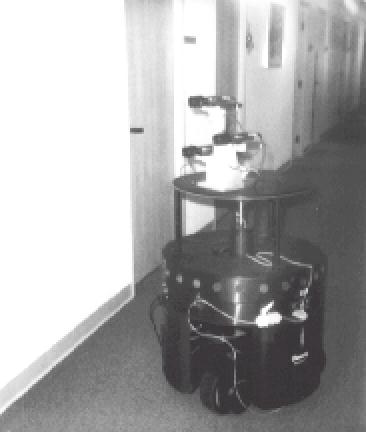 The YODA project consists of
a group of young researchers who share a passion for autonomous systems
that can bootstrap their knowledge of real environments by exploration,
experimentation, learning, and discovery. Our goal is to create a mobile
agent that can autonomously learn from its environment based on its own
actions, percepts, and missions.(Shen)
The YODA project consists of
a group of young researchers who share a passion for autonomous systems
that can bootstrap their knowledge of real environments by exploration,
experimentation, learning, and discovery. Our goal is to create a mobile
agent that can autonomously learn from its environment based on its own
actions, percepts, and missions.(Shen)
|
Marvin
 An adapted radio-controlled car called Marvin has been developed to study
reinforcement learning for navigation in a laboratory environment. (Hoff)
An adapted radio-controlled car called Marvin has been developed to study
reinforcement learning for navigation in a laboratory environment. (Hoff)
|
Rodney
 Rodney is a six-legged walking machine. This platform has been used to
explore the use of Genetic Algorithms for the development of neural
oscillator circuits that can produce walking movements. A primary
contribution of this work is the idea applying staged learning as a way
of attacking the high-dimensionality of the search space.
Rodney is a six-legged walking machine. This platform has been used to
explore the use of Genetic Algorithms for the development of neural
oscillator circuits that can produce walking movements. A primary
contribution of this work is the idea applying staged learning as a way
of attacking the high-dimensionality of the search space.
|
Belgrade Hand
 Multifingered robot hands have been developed as an attempt to mimic
human hand functionality. One such hand has been developed at the
University of Southern California and the University of Novi-Sad at
Belgrade. It is called the Belgrade-USC Hand and is
a five-fingered robot hand. While the hand has five digits only four
degrees of freedom are required. A rocker arm mechanism couples two
pairs of fingers mechanically. The hand is controlled using a simple
PD strategy from a 332 micro-controller. (McHenry)
Multifingered robot hands have been developed as an attempt to mimic
human hand functionality. One such hand has been developed at the
University of Southern California and the University of Novi-Sad at
Belgrade. It is called the Belgrade-USC Hand and is
a five-fingered robot hand. While the hand has five digits only four
degrees of freedom are required. A rocker arm mechanism couples two
pairs of fingers mechanically. The hand is controlled using a simple
PD strategy from a 332 micro-controller. (McHenry)
|
Puma 560
 Until recently, we had several Puma 560s which were produced by
Unimation. This picture is actually of a robot at UIUC (but they all
look the same!). Our Puma setup included a SunVideo frame grabber and
a Lord force sensor. We typically use the RCCL programming language.
Recently we used the Pumas for research in force control, motion
planning, and even a web interface to a museum statue. (McHenry)
Until recently, we had several Puma 560s which were produced by
Unimation. This picture is actually of a robot at UIUC (but they all
look the same!). Our Puma setup included a SunVideo frame grabber and
a Lord force sensor. We typically use the RCCL programming language.
Recently we used the Pumas for research in force control, motion
planning, and even a web interface to a museum statue. (McHenry)
|
 Dubbed "The
Socially Mobile", Don Quixote, Don Corleone, Donna E. Mobile, and The
Donald were manufactured by IS Robotics and were generously given to the
Interaction Lab by Prof. Rodney A.
Brooks from the MIT AI Lab. Each
R2e robot is a holonomic base actuated with two drive motors and equipped
with a two-fingered gripper. The sensors include piezo-electric bump
sensors on the inside panels and in the gripper, five infra red (IR)
sensors around the body and one on each finger, a color sensor in the
gripper, a radio transmitter/receiver for communication and data
gathering, a base station, and an ultrasound triangulation system for
positioning. The robots are programmed in the Behavior Language based on
the Subsumption Architecture. The Socially Mobile have participated in
various experiments on group behavior and multi-robot learning, and have
provided data for developing analysis and modeling methods. (Mataric´, Goldberg)
Dubbed "The
Socially Mobile", Don Quixote, Don Corleone, Donna E. Mobile, and The
Donald were manufactured by IS Robotics and were generously given to the
Interaction Lab by Prof. Rodney A.
Brooks from the MIT AI Lab. Each
R2e robot is a holonomic base actuated with two drive motors and equipped
with a two-fingered gripper. The sensors include piezo-electric bump
sensors on the inside panels and in the gripper, five infra red (IR)
sensors around the body and one on each finger, a color sensor in the
gripper, a radio transmitter/receiver for communication and data
gathering, a base station, and an ultrasound triangulation system for
positioning. The robots are programmed in the Behavior Language based on
the Subsumption Architecture. The Socially Mobile have participated in
various experiments on group behavior and multi-robot learning, and have
provided data for developing analysis and modeling methods. (Mataric´, Goldberg)


 MENO is a 12 DOF walking robot built and programmed by Gaurav Sukhatme, Scott Cozy and
Scott Brizius. The detailed design and control methodology is the subject
of a paper that appeared recently. Each leg is a rotational, rotational,
prismatic structure actuated by three servos. The robot has several simple
sensors. Each foot has a contact sensor to detect ground contact, a switch
that detects hyper-retraction of the prismatic joint and a switch ring
that detects contact with obstacles when the leg is swung. The robot uses
an inclinometer to maintain balance and walks in a variety of statically
stable gaits. A frontal sonar is used to detect obstacles. All processing
is done onboard using a Motorola 68332 processor programmed in C. The
robot was used as a testbed for experiments in mobility benchmarking
experiments on a project funded by the JPL Mars explorer program. The robot will be used in the future for experiments in cerebellar control.(MARS Team)
MENO is a 12 DOF walking robot built and programmed by Gaurav Sukhatme, Scott Cozy and
Scott Brizius. The detailed design and control methodology is the subject
of a paper that appeared recently. Each leg is a rotational, rotational,
prismatic structure actuated by three servos. The robot has several simple
sensors. Each foot has a contact sensor to detect ground contact, a switch
that detects hyper-retraction of the prismatic joint and a switch ring
that detects contact with obstacles when the leg is swung. The robot uses
an inclinometer to maintain balance and walks in a variety of statically
stable gaits. A frontal sonar is used to detect obstacles. All processing
is done onboard using a Motorola 68332 processor programmed in C. The
robot was used as a testbed for experiments in mobility benchmarking
experiments on a project funded by the JPL Mars explorer program. The robot will be used in the future for experiments in cerebellar control.(MARS Team)
 The Nerd Herd is a gang of 20 R1 robots manufactured by ISX/IS
Robotics. They are Ackerman steered bases about 13" long with "forks"
that can be used to pick up and stack objects. They have IR and
contact sensors on the ends of the forks, bump sensors on the sides
and back, and a radio-sonar positioning and communication system.
They are controlled by a network of 68HC11 processors programmed in
the Behavior Language. These robots were the first to demonstrate
large scale group behavior (foraging, following, flocking, etc. with
up to 13 robots); now they are in need of some body-building, and are
largely used as mobile/dynamic obstacles and targets in other
multi-robot control and coordination experiments. (Mataric, Werger)
The Nerd Herd is a gang of 20 R1 robots manufactured by ISX/IS
Robotics. They are Ackerman steered bases about 13" long with "forks"
that can be used to pick up and stack objects. They have IR and
contact sensors on the ends of the forks, bump sensors on the sides
and back, and a radio-sonar positioning and communication system.
They are controlled by a network of 68HC11 processors programmed in
the Behavior Language. These robots were the first to demonstrate
large scale group behavior (foraging, following, flocking, etc. with
up to 13 robots); now they are in need of some body-building, and are
largely used as mobile/dynamic obstacles and targets in other
multi-robot control and coordination experiments. (Mataric, Werger)
 Robot soccer competition provides an excellent opportunity for robotics
research. In particular, robot players in a soccer game must perform
real-time visual recognition, navigate in a dynamic field, track moving
objects, collaborate with teammates, and hit the ball in the correct
direction. All these tasks demand robots that are autonomous (sensing,
thinking, and acting as independent creatures), efficient (functioning
under time and resource constraints), cooperative (collaborating with each
other to accomplish tasks that are beyond individual's capabilities), and
intelligent (reasoning and planing actions and perhaps learning from
experience). Furthermore, all these capabilities must be integrated into
a single and complete system. To build such integrated robots, we should
use different approaches from those employed in separate research
disciplines. This paper describes our experience (problems and solutions)
in this aspect for building soccer robots. Our robots share the same
general architecture and basic hardware, but they have integrated
abilities to play different roles (goal-keeper, defender or forward) and
utilize different strategies in their behavior. Our philosophy in
building these robots is to use the least possible sophistication to make
them as robust as possible. In the 1997 RoboCup competition, these robots,
formed a team called Dreamteam , played well and
won the world championship in the middle-sized robot league. (Shen)
Robot soccer competition provides an excellent opportunity for robotics
research. In particular, robot players in a soccer game must perform
real-time visual recognition, navigate in a dynamic field, track moving
objects, collaborate with teammates, and hit the ball in the correct
direction. All these tasks demand robots that are autonomous (sensing,
thinking, and acting as independent creatures), efficient (functioning
under time and resource constraints), cooperative (collaborating with each
other to accomplish tasks that are beyond individual's capabilities), and
intelligent (reasoning and planing actions and perhaps learning from
experience). Furthermore, all these capabilities must be integrated into
a single and complete system. To build such integrated robots, we should
use different approaches from those employed in separate research
disciplines. This paper describes our experience (problems and solutions)
in this aspect for building soccer robots. Our robots share the same
general architecture and basic hardware, but they have integrated
abilities to play different roles (goal-keeper, defender or forward) and
utilize different strategies in their behavior. Our philosophy in
building these robots is to use the least possible sophistication to make
them as robust as possible. In the 1997 RoboCup competition, these robots,
formed a team called Dreamteam , played well and
won the world championship in the middle-sized robot league. (Shen)
 The YODA project consists of
a group of young researchers who share a passion for autonomous systems
that can bootstrap their knowledge of real environments by exploration,
experimentation, learning, and discovery. Our goal is to create a mobile
agent that can autonomously learn from its environment based on its own
actions, percepts, and missions.(Shen)
The YODA project consists of
a group of young researchers who share a passion for autonomous systems
that can bootstrap their knowledge of real environments by exploration,
experimentation, learning, and discovery. Our goal is to create a mobile
agent that can autonomously learn from its environment based on its own
actions, percepts, and missions.(Shen)
 An adapted radio-controlled car called Marvin has been developed to study
reinforcement learning for navigation in a laboratory environment. (Hoff)
An adapted radio-controlled car called Marvin has been developed to study
reinforcement learning for navigation in a laboratory environment. (Hoff)
 Rodney is a six-legged walking machine. This platform has been used to
explore the use of Genetic Algorithms for the development of neural
oscillator circuits that can produce walking movements. A primary
contribution of this work is the idea applying staged learning as a way
of attacking the high-dimensionality of the search space.
Rodney is a six-legged walking machine. This platform has been used to
explore the use of Genetic Algorithms for the development of neural
oscillator circuits that can produce walking movements. A primary
contribution of this work is the idea applying staged learning as a way
of attacking the high-dimensionality of the search space.
 Multifingered robot hands have been developed as an attempt to mimic
human hand functionality. One such hand has been developed at the
University of Southern California and the University of Novi-Sad at
Belgrade. It is called the Belgrade-USC Hand and is
a five-fingered robot hand. While the hand has five digits only four
degrees of freedom are required. A rocker arm mechanism couples two
pairs of fingers mechanically. The hand is controlled using a simple
PD strategy from a 332 micro-controller. (McHenry)
Multifingered robot hands have been developed as an attempt to mimic
human hand functionality. One such hand has been developed at the
University of Southern California and the University of Novi-Sad at
Belgrade. It is called the Belgrade-USC Hand and is
a five-fingered robot hand. While the hand has five digits only four
degrees of freedom are required. A rocker arm mechanism couples two
pairs of fingers mechanically. The hand is controlled using a simple
PD strategy from a 332 micro-controller. (McHenry)
 Until recently, we had several Puma 560s which were produced by
Unimation. This picture is actually of a robot at UIUC (but they all
look the same!). Our Puma setup included a SunVideo frame grabber and
a Lord force sensor. We typically use the RCCL programming language.
Recently we used the Pumas for research in force control, motion
planning, and even a web interface to a museum statue. (McHenry)
Until recently, we had several Puma 560s which were produced by
Unimation. This picture is actually of a robot at UIUC (but they all
look the same!). Our Puma setup included a SunVideo frame grabber and
a Lord force sensor. We typically use the RCCL programming language.
Recently we used the Pumas for research in force control, motion
planning, and even a web interface to a museum statue. (McHenry)

 The hopper is a one-legged hopping robot whose purpose is to study the
balance and energetics of dynamically stable systems. Different control
systems have been developed including a neural network for speed control and a
model-based height controller. The robot is also capable of a scooting mode of
locomotion using only the actuators utilized in hopping.
The hopper is a one-legged hopping robot whose purpose is to study the
balance and energetics of dynamically stable systems. Different control
systems have been developed including a neural network for speed control and a
model-based height controller. The robot is also capable of a scooting mode of
locomotion using only the actuators utilized in hopping.
 Bandit-I is a prototype humanoid robot. To construct a robot that is cost-effective, we have
made the robot out of servo-motors and rapid-prototyping (rp) material. It has two 6-DOF arms,
a head than can pan and tilt, and a face with movable mouth and eye-brows, and stereo-cameras for
eyes. Our goal for this robot is to have a platform to interact with people with expressive
gestures, and facial expressions.
Bandit-I is a prototype humanoid robot. To construct a robot that is cost-effective, we have
made the robot out of servo-motors and rapid-prototyping (rp) material. It has two 6-DOF arms,
a head than can pan and tilt, and a face with movable mouth and eye-brows, and stereo-cameras for
eyes. Our goal for this robot is to have a platform to interact with people with expressive
gestures, and facial expressions.  Clara is a modular mobile robot platform used in a suite of
Clara is a modular mobile robot platform used in a suite of 
 The
The